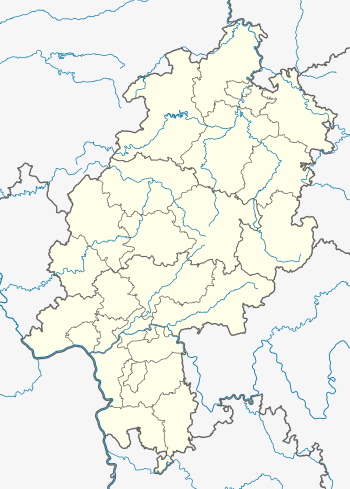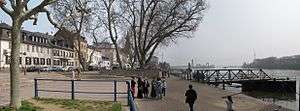Biebrich (Wiesbaden)
Biebrich is a borough of the city of Wiesbaden, Hesse, Germany. With over 36,000 inhabitants, it is the most-populated of Wiesbaden's boroughs. It is located south of the city center on the Rhine River, opposite the Mainz borough of Mombach. Biebrich was an independent city until it was incorporated into Wiesbaden in 1926.
Biebrich | |
|---|---|
Borough of Wiesbaden | |
 Biebrich Palace | |
 Coat of arms | |
Location of Biebrich in Wiesbaden | |
 Biebrich  Biebrich | |
| Coordinates: 50°03′00″N 8°14′00″E | |
| Country | Germany |
| State | Hesse |
| District | Urban district |
| City | Wiesbaden |
| Government | |
| • Mayor of Borough | Wolfgang Gores (CDU) |
| Area | |
| • Total | 12.99 km2 (5.02 sq mi) |
| Population (31.10.2008[1]) | |
| • Total | 36,792 |
| • Density | 2,800/km2 (7,300/sq mi) |
| Time zone | CET/CEST (UTC+1/+2) |
| Postal codes | 65203 |
| Dialling codes | 0611 |
History

Numerous prehistoric and early-historical archeological finds indicate that the Biebrich area has been continuously inhabited since the Neolithic Age. In the Middle Ages, from the beginning of the reign of Charlemagne, the places Biburc (Biebrich) and Moskebach (Mosbach) were part of the Königssondergau Wiesbaden, held by the Frankish king as his personal property.
Biebrich was first mentioned in historical documents in 874. King Louis the German and his entourage boarded vessels at Villa Biburg on a trip from Frankfurt to Aachen.
Beginning of the 18th century, the princes (Fürsten) of Nassau built the Baroque Biebrich Palace (Schloss Biebrich). When this magnificent building was completed in 1744, the Prince of Nassau-Usingen relocated his residence from the far side of the Taunus to Biebrich. Until the completion of the City Palace in Wiesbaden in 1841, Biebrich was the principal residence of the Princes (and, after 1806, the Dukes) of Nassau.[2]
In the 19th century, Biebrich became an important industrial center of the Rhine Main Area with the plants of Dyckerhoff Concrete (now owned by Buzzi Unicem), Kalle and Albert Chemistry (now Celanese), and Henkell (sparkling wine = Sekt). In the economical crisis of the post-World War I Era, the small town, struck hard by unemployment of the majority of his working-class residents, merged with the bigger and much wealthier nearby spa city of Wiesbaden.
In 1951, the 633rd AAA Gun Battalion, 90mm, 7th Army U.S. NATO Occupation Forces were stationed in Biebrich.
Famous residents of Biebrich
- In 1862, Richard Wagner lived for one year in a newly built country house (later called Villa Annika) near the castle at the bank of the river Rhine, working on the first act and the prelude of the third act of Die Meistersinger. Following the composer's wishes, local wind instrument producer Wilhelm Heckel invented the so-called "Heckelphone" (a basso-oboe, used by Richard Strauss, Paul Hindemith, and others).
- Sofia of Nassau, Queen consort of Sweden and Norway (May 12, 1873 - December 8, 1907), wife of King Oscar II, was born Princess Sofia Wilhelmina Mariana Henrietta of Nassau in Biebrich on 9 July 1836.
- Seligman Baer (1825–1897), a Biblical scholar and scholar of Jewish liturgy, was born and died in Biebrich, where he lived much of his life.
- Wilhelm Dilthey (1833–1911) and Wilhelm Heinrich Riehl (1823–1897), two pioneers of the early German Kulturgeschichte (cultural studies) of the 19th century, grew up in Biebrich.
- General Ludwig Beck was born in Biebrich in 1880. He lost his life struggling against Hitler's regime in the failed revolt of German officers on 20 July 1944. If this coup d'état had succeeded, Beck would have been nominated by his conspirators to be the first postwar President of Germany.
- Physicist Walter Gerlach was born in Biebrich on August 1, 1889. With Otto Stern, Gerlach co-discovered space quantization in a magnetic field, the Stern-Gerlach effect. Their experiment demonstrated that electrons and atoms have intrinsically quantum properties, and how measurement in quantum mechanics affects the system being measured.
- Former German footballer Jürgen Grabowski (born July 7, 1944 in Wiesbaden) grew up Biebrich and was part of two youth clubs in Biebrich (FV Biebrich 1902 und SV Biebrich 1919). He played for many years at Eintracht Frankfurt, which won the German Cup in 1974 and 1975 and the UEFA Cup in 1980. He made 44 appearances with the German national team and scored five goals. He was a member of the German squad in the World Cups of 1966 (in which he did not play), 1970 and 1974.
- Toni Sender, the socialist politician, was born in Biebrich in 29 November, 1888
References
- Bevölkerung in den Ortsbezirken am 31. Oktober 2008 (population statistics by borough, October 31, 2008). Official city government website. Source: Bestandsdatensatz "Einwohnerwesen", Bevölkerung am Ort der Hauptwohnung. Retrieved on 2008-12-11.
- History of Biebrich (in German). Retrieved on 2008-12-14.
Sources
- Derived from German Wikipedia
External links
| Wikimedia Commons has media related to Wiesbaden-Biebrich. |
- Private unofficial Wiesbaden-Biebrich website (in German)
